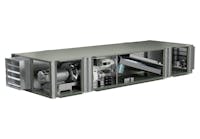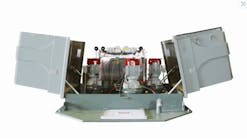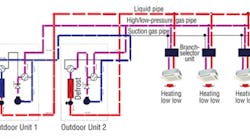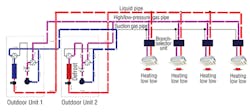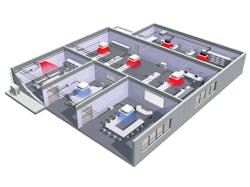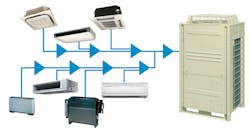TO READ PART 1 OF THIS ARTICLE, CLICK HERE.
Variable-air-volume (VAV) systems with air terminal units have been used extensively in commercial and institutional buildings in the United States for decades. Unfortunately, optimized design of a VAV system with terminal heat is difficult at best because of limitations inherent in VAV and complications posed by design standards and regulations. One new approach involves the pairing of a dedicated outdoor-air system (DOAS) with a variable-refrigerant-flow (VRF) system. By separating the goal of achieving ventilation rates from the goal of maximizing thermal comfort, we can avoid situations in which the two goals are in conflict and efforts suffer from the resulting compromises. What’s more, we can simplify the design process and find system efficiencies that go far beyond those commonly achieved with VAV systems with terminal heating.
Part 1 of this two-part article (March 2014) discussed the limitations of VAV design and VAV systems. Part 2 will discuss the merits and challenges of combining DOAS and VRF systems as an alternative to VAV systems.
Advantages of DOAS
DOAS provide ventilation air directly to occupiable spaces, usually separately from heating and cooling functions. Thus, the central air-handling fan, ductwork, and diffusers of a DOAS are smaller and use less power than those of a VAV system that provides cooling. At the same time, separation of ventilation from heating and cooling functions enables designers to separate ventilation reset from heating turndown, allowing supply-air-temperature reset, supply-air-pressure reset, and dynamic-ventilation reset to be performed by different parts of the systems, which simplifies calculations.
With DOAS ventilators, heat recovery can be provided internally, qualifying for exceptions from requirements for outside-air economizers and further simplifying units and controls. DOAS heat-recovery damper control including bypass and defrost is a well-established routine in packaged ventilator controls and much simpler than the custom sequences of VAV control.
Energy recovery can be incorporated at the system level with commercially available products, such as a heat wheel or stacked-plate heat exchanger. In addition to using local packaged controls, these commonly incur maintenance costs lower than those of a larger, centralized VAV air-handling unit (AHU). Another advantage of heat recovery through DOAS is a potential reduction in building cooling tonnage. If this approach is conceived during design, savings from the smaller chiller or VRF condensing unit can be used to offset the cost of the heat-recovery equipment. Also, because buildings with energy recovery are slower to warm, during a load-shedding event as part of a demand-response action, a chiller can remain off for a longer period of time.
As in a VAV system, bypass dampers may be needed at energy-recovery heat exchangers, but the dampers will be smaller, and their design with regard to pressure losses can be more flexible.
DOAS need fan power only for ventilation air, which reduces fan horsepower and helps to meet energy codes.
System pressure losses (and resultant fan horsepower) can be lower than with a VAV system because power is not needed to move cooling air through terminal heating coils. Also, less pressure generally is needed to operate and control terminal units, which reduces parasitic losses and helps to meet energy codes.
With DOAS, ventilation reset generally can be performed at the zone, rather than system, level using much simpler hardware and controls, such as ventilation dampers in “densely populated areas” (conference rooms, in particular) and spaces in which pressurization is critical. With smaller fans with better turndown efficiency, fan efficiency can be higher at turndown airflows. In some applications, DOAS can take advantage of multiple smaller fans, as in the practice of shutting down individual units in modular supply-fan walls to keep individual fans running on their best efficiency points. Because they handle only ventilation air, DOAS supply fans are smaller, which means easier and less costly repair, replacement, and modification.
System air and water balancing also is much simpler, with fewer components and less iterative balancing of air and heating-water flows.
With DOAS, duct space is needed for ventilation only. For many climates, a rule of thumb for sizing ducts is 30 percent of economizer airflow. The resultant considerably smaller ducts can be important in retrofits of older buildings.
In general, DOAS require less ceiling space for reheat terminal units, which reduces or eliminates the need for coordinated space for electrical-power clearances at terminal units and space for maintenance access to terminal-unit controls and reheat coils. While, with a VAV system, demand control ventilation (DCV) in densely populated areas typically requires terminal units, with a DOAS, it sometimes can be accomplished with less expensive conventional airflow dampers.
Control of dampers for ventilation can be much simpler, with DCV provided in a local densely populated zone, such as a conference room, based simply on the occupancy status or carbon-dioxide content of that zone, without the dynamic-cooling/ventilation resets of the rest of the system being affected.
Simpler space-pressure control is another advantage of DOAS. Reductions in the air supplied to a room can be accompanied by reductions in the air exhausted; thus, room pressure is maintained, and adjacent rooms are unaffected.
Complex zone temperature control, such as terminal-unit pressure-independent flow control, is less necessary with DOAS because air usually is tempered only for delivery to a room, while space temperature control is accomplished with a wholly separate heating/cooling system, often with packaged commercial controls, rather than locally customized software. Typically, DOAS provide neutral-temperature (70°F or so) ventilation air, rather than cooling air (typically, about 55°F with reset). DOAS temperature, however, can be reset, particularly when a building is in cooling or heating mode overall. Space heating and cooling requirements can be reduced through use of outside air, similar to air-economizer “free cooling.” In some applications, additional energy savings may be available through use of outside air for dehumidification.
Dehumidification also is somewhat more flexible in a DOAS/VRF configuration. For example, in climates with significant outside-air dehumidification requirements, the majority of dehumidification can be provided at the DOAS unit, similar to using the cooling coil in a built-up VAV system. For individual spaces with dehumidification needs, moisture removal can be accomplished at the fan-coil unit.
DOAS generally are closer to constant-volume supply than are VAV systems; airflow is close to that for which diffusers are selected for more of the time. Similarly, VRF systems are closer to being constant volume, helping to maintain diffuser throw, particularly during heating operation, increasing ventilation effectiveness.
From an integrated-design perspective, DOAS/VRF can aid implementation of advanced air-distribution strategies, including displacement ventilation and underfloor air distribution (UFAD). Displacement ventilation and UFAD require less energy and offer greater ventilation effectiveness and higher contaminant-removal rates than traditional full-room air mixing. Displacement ventilation and UFAD improve not only how ventilation air gets to an occupied space, but how it moves to and through the breathing zone. Displacement-ventilation and UFAD approaches offer options in the areas of natural ventilation for entire buildings or hybrid ventilation to move more air when building delta-T is low. Displacement-ventilation and UFAD strategies have higher contaminant-removal rates, as well as better air-distribution effectiveness. Furthermore, displacement ventilation and UFAD increase energy effectiveness by reducing fan-power use and lowering heat-removal costs by reducing the treatment of air above the occupied zone of a room.
The capital cost of a DOAS with separate heating/cooling system is comparable to that of a VAV system. The life-cycle cost of a DOAS with separate heating/cooling system, however, can be lower because of greater system energy effectiveness, ventilation effectiveness, reliability, and maintainability.
Advantages of VRF
VAV systems often use heated and chilled water to transfer heat to and from air supplied for space heating and cooling and ventilation pre-treatment. With smaller systems, terminal heating/cooling units often employ traditional direct-expansion (DX) heat transfer using piped refrigerant. Traditional DX systems have one evaporator coil per fan unit piped to a single condensing unit located outdoors. Sometimes, the DX can be reversible, providing heat, rather than cooling, to supply air.
A VRF system, on the other hand, can have several evaporator coils piped to a condensing unit (Figure 1), which allows the condensing unit to operate only at the current net total heating or cooling capacity (whichever is greater) and enables heat transfer from zones with excess heat to zones with heat demand (Figure 2). The larger number of evaporator coils leads to greater individual space temperature control. Each conditioned zone has heating- or cooling-capacity modulation via a refrigerant valve at the fan coil, while the central system typically has capacity modulation via a staged or variable-speed compressor.
The heat-recovery function of a VRF system can lower energy cost directly by transferring excess heat from spaces being cooled to spaces needing heat. Power input to modern VRF systems is considerably lower than that to traditional DX systems, with coefficients of performance (COP) as high as 3.8, compared with the COP of less than 3.0 of DX systems.
VRF systems generally have smaller components to maintain and better system redundancy. Thus, maintenance is less expensive and less impactful on building operations. VRF fan-coil units often are designed to be maintained within an occupied space, not requiring access doors or ceiling-tile removal.
In VRF systems, piping from evaporator coils to condensers often is smaller because heat is carried in specialized refrigerants, instead of heating water or chilled water. While VRF piping systems may have a greater number of individual lines, pairs of smaller lines can be run next to each other in piping racks, taking up less vertical space than larger-diameter heating-water/chilled-water piping.
VRF systems sometimes suffer from the stigma of cold DX cooling air (maybe 45°F to 50°F, as compared with 55°F VAV air), but spaces can be quite comfortable when cooling air is distributed properly and supply-air temperature is reset. Additionally, supply air is necessary in VRF systems only when a space needs heating or cooling. Supply-air-temperature reset can be granular to the zone, rather than selected based on system-level parameters, such as outside-air temperature.
Unlike traditional DX systems, VRF systems generally do not require a full periodic reversal for defrost of outdoor coils during heating season. DX-system defrost cycles on traditional heat pumps can inject cold air into occupied spaces periodically when heat is needed, which, of course, can lead to discomfort or added cost for reheat. Where there is no ducted outside air (as in an overlaid DOAS/VRF system), some or all fan coils can be stopped during defrost. Alternatively, supplemental heat can be provided at individual fan coils, as opposed to all coils, and some VRF systems use split coils to avoid full defrost.1 Even better, with modular outdoor units, a single unit can be taken offline and reversed for defrost, while all fan coils remain in heating mode (Figure 3). These VRF techniques for reducing (or eliminating) electric heat for defrost can have a substantial impact on energy-cost reduction and sometimes even reduce building electrical-service size.
Building heating/cooling loads and fan-power requirements vary simultaneously. These independent variables contribute to the difficulty of estimating real-time total building loads. Thus, VAV central equipment can be oversized considerably, resulting in equipment-efficiency losses and extra facility costs, such as additional support structure. Sizing of a VRF system can be based on building-envelope “block” (net) loads plus peak internal loads, while sizing of a DOAS can be based on peak population. These are more easily estimable.
With the combination of a DOAS and a VRF system, ventilation airflow, ventilation pre-cooling, and ventilation pre-heating are handled by the DOAS, while space heating and cooling are handled by the VRF system. This simplifies design, as simultaneous pressure effects of various overlapped control schemes are avoided.
VRF systems are much less prone to inefficient modes of operation, such as reheat and recooling, than are VAV systems. For example, with a VAV system in typical winter or shoulder-season operation, air will be cooled mechanically at the central system, delivered to interior zones with heavy lighting and people loads, and then reheated by exterior terminal units for spaces requiring heat.
With VRF systems, there often is little or no ductwork at occupied spaces. Larger areas may require ductwork for local air distribution from fan-coil units, but most spaces can be served with ductless fan coils mounted either on walls or within suspended ceilings. Various types of fan-coil units are available (Figure 4).
VRF heat transfer is accomplished with copper tubing, installation of which is relatively simple compared with custom ductwork. The tubing is relatively small, although circuits can be numerous.
VRF systems offer greater flexibility for retrofits, including interior-space remodels, because refrigerant piping often just needs to be changed back to a zone-level distribution assembly. This can be much less intrusive than modifying ductwork all of the way back to distribution mains or back to an AHU. Additionally, VRF-system redundancy can allow individual refrigerant circuits to operate while one is undergoing maintenance, repair, or replacement. Because VRF outdoor units often are modular, expansion of a system to accommodate the expansion of a building can be relatively painless.
Air-cooled condensing units for VRF systems can be located almost anywhere outside (e.g., rooftops, storage facilities, dedicated exterior rooms), as long as refrigerant piping is sized and routed as usual for DX systems. In high-rise buildings, these units can be located on each floor, as opposed to a VAV system serving the floor with limited load diversity or piping and ductwork routed to central mechanical rooms, to the roof, or to grade.
Air-cooled condensing units with inverter compressors (variable speed) also are available for VRF systems. These adjust central-equipment capacity to system need more efficiently than increasing/reducing fan speed does.
VRF is mature technology, with several major manufacturers worldwide. VRF systems are in operation throughout Asia and Europe and making significant inroads into U.S. markets, often in green buildings.2 VRF controls with new-generation user interfaces that include Internet-browser screens and even smartphone applications to facilitate remote adjustments and troubleshooting now are being manufactured.
VRF systems can represent “one-stop shopping” for designers and contractors, as compared with built-up VAV systems, which typically require coordination of equipment from several manufacturers.
Lastly, DOAS/VRF systems pay for themselves. Conceptually, approximately 20 percent higher capital cost (mechanical only, ignoring structural savings) can be expected. But considering energy savings of approximately 10 percent per year, payback periods often are five years or less.
VRF Drawbacks (Real and Perceived)
Though attractive from many perspectives, DOAS/VRF systems do have drawbacks. First, with increased use of refrigerants, safety is a consideration. Calculations are required to verify occupants are not exposed to more than the allowable concentration of refrigerant (see “Applying Refrigerant Codes” by Greg Cunniff, PE, December 2013). Safety measures, such as refrigerant monitors, air-transfer ducts, and dampers, may be required.
VRF systems generally are available for relatively small zones. For relatively large spaces, such as cafeterias, gymnasiums, theaters, and conference rooms, separate HVAC units may be required.
Copper refrigerant piping can be expensive, particularly when metals prices jump. However, some VRF manufacturers are introducing steel tubing, which has been used in automotive air-conditioning applications for many decades.
Condensate drains often are needed for individual VRF cooling coils. However, fan-coil units typically are available with low-cost accessory pumps. These pumps often use flexible tubing for condensate discharge, rather than expensive gravity condensate piping.
A separate ventilation system usually is required with VRF, but for smaller commercial and residential systems, outside air can be ducted directly from the outdoors to fan-coil units. Direct-ducted outside air often is limited to a relatively low outside-air/supply-air fraction, and using MERV13 filters per the U.S. Green Building Council’s LEED (Leadership in Energy & Environmental Design) rating system may require careful analysis of the pressure capability of fan-coil units.
Some designers have avoided VRF systems because certified performance data—often required by building codes—were not available. ANSI/AHRI Standard 1230-2010, Performance Rating of Variable Refrigerant Flow (VRF) Multi-Split Air-Conditioning and Heat Pump Equipment,1 standardizes energy-efficiency ratings of VRF systems. As a result, documentation is now available for VRF systems. In addition to simplifying the permit process, this documentation helps to validate that VRF systems provide energy-efficiency ratios not available with built-up VAV systems.
Summary/Conclusion
VAV reheat systems once were convenient and made good economic sense for use with high air-change rates. Today, stretching VAV designs to address the competing motives of good ventilation and energy savings can be complex and expensive.
By combining a DOAS with an inherently efficient heating and cooling system, such as VRF, a system designer can find system efficiencies that go far beyond those commonly achieved with VAV with terminal heat.
Designers would be well-served to break through to the new DOAS paradigm and consider supplementing their DOAS with VRF. Such systems take advantage of VRF’s inherent energy recovery, better controllability, ease of design coordination, and reduced space requirements. In addition to simplifying system design and operation, the use of DOAS/VRF, in lieu of old-style VAV reheat, provides “greener” systems by reducing both energy use and overall life-cycle cost.
References
1) AHRI. (2010). Performance rating of variable refrigerant flow (vrf) multi-split air-conditioning and heat pump equipment. ANSI/AHRI Standard 1230-2010. Arlington, VA: Air-Conditioning, Heating, and Refrigeration Institute.
2) ASHRAE. (2012). ASHRAE handbook—HVAC systems and equipment. Atlanta: ASHRAE.
Grant Bowers, PE, LEED AP, is a mechanical engineer with SSOE Group, provider of architecture, engineering, construction-management, and specialized services worldwide. Over the last 20-plus years, he has developed expertise in the design of mechanical systems and management of mechanical design and construction projects for manufacturing, cleanroom, laboratory, office, government, medical, and education facilities. He can be contacted at 503-439-8777 or [email protected].
Did you find this article useful? Send comments and suggestions to Executive Editor Scott Arnold at [email protected].




